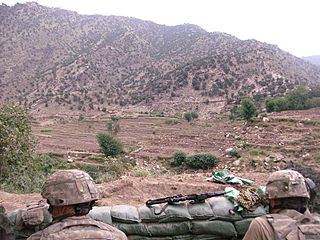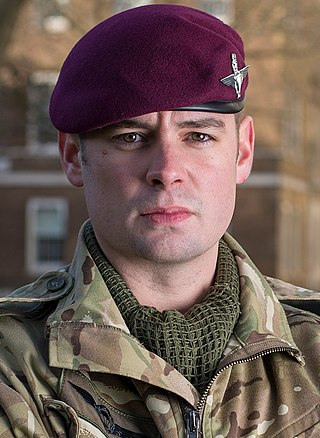Related Research Articles

The United Kingdom was one of the first countries to take part in Operation Enduring Freedom against the Taliban regime in autumn 2001.

Operation Herrick was the codename under which all British operations in the War in Afghanistan were conducted from 2002 to the end of combat operations in 2014. It consisted of the British contribution to the NATO-led International Security Assistance Force (ISAF), and support to the American-led Operation Enduring Freedom (OEF), within the South Asian country.

Corporal Bryan James Budd, was a British Army soldier and a Northern Irish recipient of the Victoria Cross (VC), the highest award for gallantry in the face of the enemy that can be awarded to British and Commonwealth forces.

Mark William Wright, GC was a soldier in the British Army and a recipient of the George Cross. He died in Helmand Province, Afghanistan, after entering a minefield in an attempt to save the lives of other injured soldiers. His actions were posthumously recognised with the award of the George Cross on 14 December 2006, and gazetted the next day. Wright had served in the 3rd Battalion, Parachute Regiment in Northern Ireland, Iraq and Afghanistan.

Kajaki is a village in southern Afghanistan, and is split between two townsteads, Kajaki 'Olya, and Kajaki Sofla. It is the district centre of Kajaki District in Helmand Province. North east of the village is an important hydro power station for electricity and irrigation projects, the Kajaki Dam. The village itself hugs the east side of the Helmand River, right after it makes its first turn south, one km out from the dam. Kajaki is bordered by the town Payson to its west, Tangeye, an abandoned bazaar to its north, Shabez Kheyl, and Kanzi to its north west, all across the Helmand. Kajaki serves as the northern terminus of Route 611.

Operation Achilles was a NATO operation, part of the War in Afghanistan. Its objective was to clear Helmand province of the Taliban. The operation began on March 6, 2007. The offensive is the largest NATO-based operation in Afghanistan to date. NATO officials reported that, contrary to previous operations, Taliban fighters were avoiding direct confrontation in favor of guerilla tactics.

The siege of Sangin was a military engagement which occurred between June 2006 and April 2007, between Taliban insurgents and the British Army during the war in Afghanistan. During the engagement, the district centre of Sangin District in Helmand Province was occupied by British forces and was completely surrounded by Taliban fighters. At one point fighting became intensive, causing General David J. Richards, the then-NATO commander in Afghanistan, to declare that Helmand province had seen the fiercest fighting involving British troops since the Korean War. The siege became emblematic of the difficulty of the mission being carried out by British soldiers in Afghanistan, who nicknamed it "Sangingrad".

The Helmand province campaign was a series of military operations conducted by the International Security Assistance Force (ISAF) forces against Taliban insurgents and other local groups in the Helmand Province of Afghanistan. Their objective was to control a province that was known to be a Taliban stronghold, and a center of opium production. None of the ISAF's intended strategic and political objectives were achieved in the long term.
The Battle of Musa Qala was a British-led military action in Helmand Province, southern Afghanistan, launched by the Afghan National Army and the International Security Assistance Force (ISAF) against the Taliban on 7 December 2007. After three days of intense fighting, the Taliban retreated into the mountains on 10 December. Musa Qala was officially reported captured on 12 December, with Afghan Army troops pushing into the town centre.

Ross Kemp in Afghanistan is a Sky One British documentary series fronted by actor Ross Kemp about the British soldiers fighting in the War in Afghanistan as part of the International Security Assistance Force (ISAF) mission against the Taliban. The first two series involved Kemp and a small embedded film crew following troops fighting in Helmand Province, documenting their part in the ongoing Operation Herrick.

The Battle of Wanat took place on July 13, 2008, when around 200 Taliban insurgents attacked American troops stationed near Quam, in the Waygal district of Afghanistan's far eastern Nuristan province. The distant position was primarily defended by United States Army soldiers with 2nd Platoon, Chosen Company, 2nd Battalion, 503rd Infantry Regiment (Airborne), 173rd Airborne Brigade Combat Team.

French International Security Assistance Force (ISAF) troops were ambushed by Afghan Taliban insurgents, with heavy casualties, in the Uzbin Valley outside the village of Spēṟ Kunday in the Surobi District of Kabul province in eastern Afghanistan on 18 August 2008.
United States and NATO International Security Assistance Force (ISAF) operations, alongside Afghan National Army forces, continued against the Taliban through 2008.
Operation Nasrat ('Triumph') was a military campaign by the Taliban insurgency in September 2007. It was focused on targeting American and Coalition forces operating in Helmand and Kabul Province.

The M1150 Assault Breacher Vehicle (ABV) is a U.S. military mine- and explosives-clearing vehicle, based on the M1 Abrams chassis, equipped with a mine plow and line charges. Its first large scale use by the US Marines (USMC) was in the joint ISAF-Afghan Operation Moshtarak in Southern Afghanistan during the War in Afghanistan in 2010 against the Taliban insurgency.
The following lists events that happened in 2013 in Afghanistan.

Kajaki: The True Story, released in North America as Kilo Two Bravo, is a 2014 British war docu-drama film directed by Paul Katis in his feature debut, written by Tom Williams, and produced by Katis and Andrew de Lotbiniere.

Colour Sergeant Joshua Mark Leakey is a British soldier currently serving in the Parachute Regiment. In 2015, Leakey was awarded the Victoria Cross, the highest military decoration for valour in the British and Commonwealth armed forces, for his involvement in a joint UK–US raid in Helmand Province, Afghanistan, on 22 August 2013. He was the only living British soldier to be awarded the Victoria Cross for the War in Afghanistan and the last person to receive it from Queen Elizabeth II.

Operation Halmazag was an offensive operation by ISAF German-led troops in close cooperation with the Afghan security forces in the province of Kunduz, from 31 October to 4 November 2010, with the aim of building a permanent outpost near the village of Quatliam in the Char Dara district, south-west of Kunduz. The operation was the first German military ground offensive since World War II.
In May 2020, a series of insurgent attacks took place in Afghanistan, starting when the Taliban killed 20 Afghan soldiers and wounded 29 others in Zari, Balkh and Grishk, Helmand on 1 and 3 May, respectively. On 12 May, a hospital's maternity ward in Kabul and a funeral in Kuz Kunar (Khewa), Nangarhar were attacked, resulting in the deaths of 56 people and injuries of 148 others, including newborn babies, mothers, nurses, and mourners. ISIL–KP claimed responsibility for the funeral bombing, but no insurgent group claimed responsibility for the hospital shooting.
References
- 1 2 3 4 "Kajaki: Turning a remarkable Afghanistan escape into a film". The Independent. 2014-11-17. Retrieved 2020-05-15.
- ↑ Heaney, Paul (November 25, 2014). "Hurt soldier's hope for Afghan film" – via www.bbc.co.uk.
- ↑ Correspondent, Thomas Harding, Defence (2007-11-10). "Mine victims to return to the frontline" . The Daily Telegraph. ISSN 0307-1235 . Retrieved 2020-05-15.
{{cite news}}: CS1 maint: multiple names: authors list (link) - ↑ "Justice For Soldiers After Horrific Kajaki Minefield Incident". Irwin Mitchell. February 2015. Retrieved 2024-05-06.
- ↑ Correspondent, Thomas Harding, Defence (2007-02-28). "Troops blown up by Afghan mines sue MoD" . The Daily Telegraph. ISSN 0307-1235 . Retrieved 2020-05-15.
{{cite news}}: CS1 maint: multiple names: authors list (link) - ↑ "Justice for Soldiers After Horrific Kajaki Minefield Incident".
